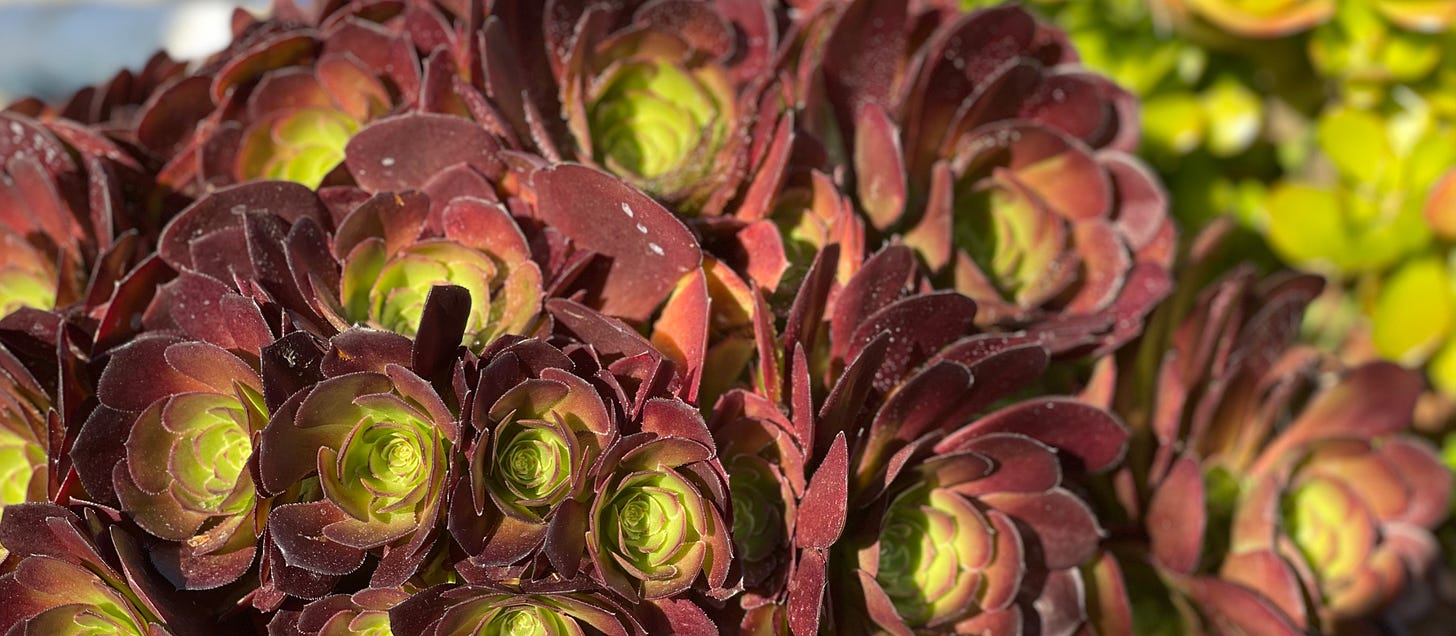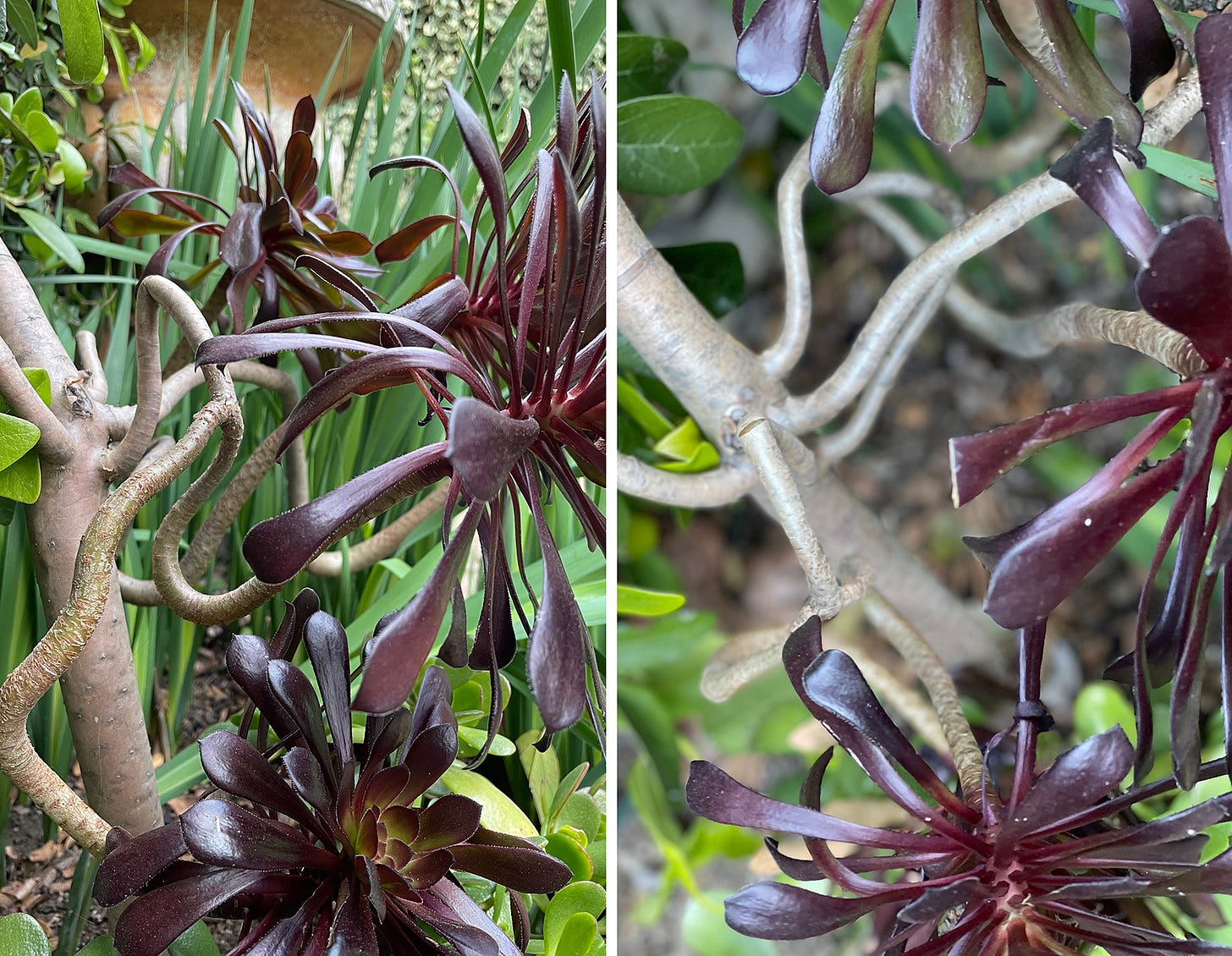How we re-root after breaking
Designing the "how" in how we work, communicate, interact and see one another to create a thriving environment.
I’m a design professor seeking to bridge the academics of environmental sustainability, the professional design community, and those who want to create change but don’t always know where to begin. We know the world around us is not sustainable, instead we need to find ways to design regeneratively - rejuvenating ourselves, our communities, and our planet. This edition looks at the how in our workforce, and how we might re-root ourselves after the last nearly two years of pandemic living.
I love succulents. They are resilient, diverse, surprising, soothing, quiet, loud, practical, unique, and beneficial to the environment in so many ways. My collections multiplies because I continually propagate them. I don’t consider myself a horticulturalist, just their keeper. When they outgrow their pot, I’ll divide them; when a stem breaks off, I root it elsewhere. For me, it’s not about creating trendy displays of pots and plants, but about love for this thing that naturally regenerates creating more beauty and function. Sometimes, with the right conditions, the smallest start can become a massive bloom.
Some years ago a friend (who happens to be the daughter of one of my mentors) was moving away and gifted me with a succulent she couldn’t take with her. It lived in my backyard in the pot she brought it in until it was too tall and I had to re-pot it. When I did, it quickly sprouted new life. We moved houses, the plant moved too. When small stems broke off, I’d re-pot them. Eventually, I started planting them in the yard where, when unbound by ceramic walls, they grew even bigger. I’ve lost track of how many plants I’ve gained from this one small gift. Currently, one of the many offshoots is growing in all directions making loops and twists and turns showing the resilience and strength of its growth. Recently I noticed a stem on this particular roller coaster was starting to break. I had a moment of sadness for this unique flowing shape would now be drastically changed. But it’s also an opportunity for this stem to re-root and become something new. Given the past two years, I feel like this plant, twisted and turned, broken, and ready to be re-rooted.
Re-rooting doesn’t always come quickly, and sometimes takes different tries. There are times when after replanting, seemingly nothing new grows. Other times they spout so quickly they need to be replanted again or divided. Sometimes they get moved around the windowsills, or pots or spots in the yard, until with the right combination of where it’s planted, what it’s planted next to, the soil it's in, the light and water and compost, it blooms, fractals, and regenerates more life.
As I’ve been working outside the past few weeks - weeding and planting new vegetables, clearing space for blooming wildflowers, and tending to my collection of succulents, I’ve been thinking about the moment we find ourselves in - trying to find our way back, re-rooting, from the pandemic.
Last fall I returned to in-person (masked and vaxxed) teaching. In the months before the semester began, there were countless emails, training, and tests of how we’d address the physical health and safety of returning to classes. Masks, cleanings, vaccination requirements, how to turn hyflex and hybrid on a dime in the event some or all of the class needed to quarantine. We tested microphones under masks and made new rules about eating and meeting. But what wasn’t prepared for, either because it was forgotten or because no one knew how to, was the mental health of the entire community in this return. Putting a bottle of hand sanitizer and packs of Clorox wipes in a classroom feels like a concrete actionable item and provides us with some sort of physical illusion of safety. But what is the equivalent preparation for the anxiety, depression, exhaustion, fatigue, and grief that is also layered in with ADHD, dyslexia, bipolar disorder, and other invisible disabilities that are becoming more and more common in young adults today? Or the demands of caring for family members, working multiple jobs, managing immigration statuses, personal relationships, and more. In many ways, the first semester back in person was the hardest semester I ever taught. While we prepared for physical accommodations, we did not prepare for mental health accommodations, most likely because no one knew how.
As a Professor, I was left with tough questions like how many classes are too many classes to miss because of mental health? Do you pass if you show up every day but are not able to complete assignments? In “before times” (pre-March 2020) these answers were clearer cut and easier, but now the heavy emotional toll on this generation was front and center. When I think of these questions I think to myself - how am I, how is my class preparing them for the “real world”? Will me making exceptions for them as a students in my class prepare them for life after college? From a future employer's perspective - will they have the skills needed to enter a job? Will a future boss allow them to take extra time past deadlines because of mental health reasons?
At the same time that I struggled with these questions, the great resignation also hit many job markets as people quit their jobs. Subsequent staffing shortages impacted services, exasperating working conditions only reinforcing the fact that (in many cases) we’ve set up unsustainable working conditions. In some ways, the struggle to complete school work I saw in my students was mirrored in those who were unable to carry on in the working conditions of their jobs. Not necessarily the physical conditions you might find in factory workers and sweatshops but in the mental health and well-being conditions of how we work, communicate, interact and see one another. A paycheck is no longer enough for many people looking to be fulfilled and honored in other ways.
Now, at the start of another new semester, I’ve revamped course policies, reconsidered project timelines, introduced new framing techniques into my classroom, all while thinking about where we are at this moment and how I want to model for students, a new way of working. The how in my classroom creates conditions to accommodate and support mental and emotional health in order to hold each other accountable for creating and delivering solid projects. This order can not be reversed. Putting the demands for work production first and support for well-being second, is exactly what burned us all out.
I pose that same question to others - how are you re-designing the how? Designers often think about what to make, where to put it, (and hopefully) why. The how is often considered in technical terms - how it will be manufactured or distributed. But what about the how in terms of how we work, how we communicate, how we interact in the process of creating?
In this post-pandemic (if we can call it that) post-great resignation (if we are there yet) time, we need to carefully consider our working relationships and interactions to develop a workplace that won't just support, but regenerate and rejuvenate people.
I remember the “early days of the pandemic” when people wore masks, goggles, and rubber gloves to the grocery store buying a month's worth of food and toilet paper, hunkering down preparing to not leave the house for weeks. There was so much that was unknown, yet there was an urgency of needing to prepare for this unknown. Throughout the past nearly two years there were so many instances I can remember where people (myself included) responded with fear, anger, exhaustion, and sadness. So many things broke, so much remains broken, and there still is so much that is unknown. The question remains - how do we prepare for the unknown?
When a succulent stem breaks off, oftentimes you can just stick it in the ground, this is part of what makes them so resilient. In some ways, that’s what has happened to many people and situations around us - broken stems just trying to grow again. The plants that usually thrive though, that multiply and bloom bursts of energy - are not just stuck in the ground. They might start in small jars of water to establish roots, moved to small pots, given fresh soil and compost, transplanted to a place in the yard that has been tilled and cared for, a place where their roots will grow and intertwine with the other plants, trees and wildflowers around them, where snails, worms, bugs, and butterflies visit. They become part of a larger ecosystems of support. This is all part of the how. All of these actions set up the conditions to allow something new to both root and bloom. It’s the same actions I consider in setting up a classroom, the same actions I ask you in creating your how.
How will you speak to others? How will you help others? How will you ask for help? How will you support work-life balance? How will you be honored? How will you honor others? How will you create the conditions for yourself and those around you to thrive?
How will you design the working conditions for yourself and your community to thrive?







